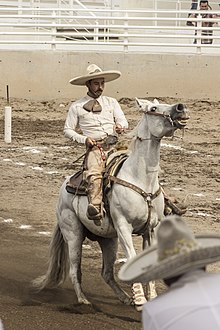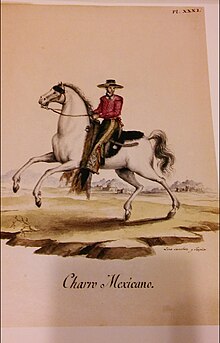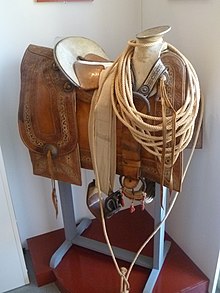Charro



Charro, in Mexico, is historically the horseman from the countryside, the Ranchero, who lived and worked in the haciendas and performed all his tasks on horseback, working mainly as vaqueros and caporales,[1] among other jobs.[2] He was renowned for his superb horsemanship, for his skill in handling the lasso, and for his unique costume designed specially for horseback riding. Today, this name is given to someone who practices charreada (similar to a rodeo), considered the national sport of Mexico which maintains traditional rules and regulations in effect from colonial times up to the Mexican Revolution.[3]
Etymology
The word charro (syn. charrar, charra) was first documented in Spain in the book "Vocabulario de refranes y frases proverbiales" (1627) by Gonzalo Correas as a synonym of dumb or stupid person.[4][5][6] More than one hundred years later, in 1729, in the first dictionary of the Spanish language edited by the Real Academia Española, the "Diccionario de Autoridades" charro was defined as:
The uneducated and unpolished person, raised in a place of little policing. In the Court, and in other places, they give this name to any person from the countryside.[7]
The first edition of the Real Academia dictionary published in 1780, kept that original definition, defining charro as: "the rough and rustic person, as the villagers tend to be"; but they would add a second meaning for the first time: "adjective that is applied to some things that are too laden with decoration and in bad taste".[8] Thus, it was a derogatory term applied to country people because they’re perceived as ignorant, rough and unsophisticated, and to things that were too laden in decoration but in bad taste. Synonymous with the English terms: yokel, bumpkin, boor, hick, gaudy and garish
Spanish-English dictionaries like the "Diccionario Español e Inglés" (1786) defined Charro as: "rustic, country like".[9] While the 1802 "A New Dictionary of the Spanish and English Languages" defined it as: "a clownish, coarse, ill-bred person" and "Gaudy, loaded with ornaments in a tasteless and paltry manner".[10]
In 1745, the Basque Jesuit, Manuel Larramendi, argued that the word was of Basque origin and that it meant: "vile and despicable thing", and wrote that country people and villagers were called that out of contempt.[11] While the historian and philosopher Antonio de Capmany y Montpalau, argued that the origin of the word was Arabic and that it originally meant "bad of moral malice and of customs" passing on to the Spanish to mean artistic malice, thus something "charro" is the same as something gaudy and tasteless.[12][13]
In Mexico, since the 18th century, the term charro was applied in a derogatory manner to the Rancheros, the inhabitants of the countryside and haciendas who carried out all their tasks on horseback, because, as country people, they were perceived as ignorant, crude and unsophisticated. Over time, the word evolved being redefined in Mexico, going from being a derogatory adjective to a noun, synonymous with Ranchero or vaquero, and "great horseman". In 1850, the Spanish historian and writer based in Mexico, Niceto de Zamacois, defined what Charro was in Mexico, as:[14]
Charros: gente del campo que se compone mucho para montar á caballo (country people who are very well formed to ride a horse).
Origins


The Viceroyalty of New Spain had prohibited Native Americans from riding or owning horses, with the exception of the Tlaxcaltec nobility, other allied chieftains, and their descendants. However, cattle raising required the use of horses, for which farmers would hire cowboys who were preferably mestizo and, rarely, Indians. Some of the requirements for riding a horse were that one had to be employed by a plantation, had to use saddles that differed from those used by the military, and had to wear leather clothing from which the term "cuerudo" (leathered one) originated.
Over time landowners and their employees, starting with those living in the Mexican Plateau and later the rest of the country, adapted their cowboy style to better suit the Mexican terrain and temperature, evolving away from the Spanish style of cattle raising. After the Mexican War of Independence horse riding grew in popularity. Many riders of mixed race became mounted mercenaries, messengers and plantation workers. Originally known as Chinacos, these horsemen later became the modern "vaqueros"[citation needed]. Wealthy plantation owners would often acquire decorated versions of the distinctive Charro clothing and horse harness to display their status in the community. Poorer riders would also equip their horses with harness made from agave or would border their saddles with chamois skin.
Mexican War of Independence and the 19th century


As the Mexican War of Independence began in 1810 and continued for the next 11 years, charros were very important soldiers on both sides of the war. Many haciendas, or Spanish owned estates, had a long tradition of gathering their best charros as a small militia for the estate to fend off bandits and marauders. When the War for Independence started, many haciendas had their own armies in an attempt to fend off early struggles for independence.[15]
After independence was achieved in 1821, political disorder made law and order hard to establish throughout much of Mexico. Large bands of bandits plagued the early 19th century as a result of lack of legitimate ways for social advance. One of the most notable gang was called "the silver ones" or the "plateados"; these thieves dressed as traditional wealthy charros, adorning their clothing and saddles with much silver, channeling the elite horseman image.[16] The bandit gangs would disobey or buy out government, establishing their own profit and rules.
Towards the mid 19th century, however, President Juárez established the "rurales" or mounted rural police to crack down on gangs and enforce national law across Mexico. It was these rurales that helped to establish the charro look as one of manhood, strength, and nationhood.[17]
During the Second Mexican Empire, Maximilian I of Mexico reigned as emperor and liked to wear a charro suit as the national costume to ingratiate himself with his subjects. He was an avid and skilled horsemen and impressed by the local charros. Emperor Maximilian himself designed the elegant all black charro traje, or costume, as acceptable attire for formal occasions, which the charros and mariachi ensembles by extension still use in modern days.[18]
Charros were quickly seen as national heroes as Mexican politicians in the late 19th century pushed for the romanticized charro lifestyle and image as an attempt to unite the nation after the conservative and liberal clashes.
Early twentieth-century usage

Prior to the Mexican Revolution of 1910, the distinctive charro suit, with its sombrero, sarape, heavily embroidered jacket and tightly cut trousers, was widely worn by men of the affluent upper classes on social occasions, especially when on horseback.[19] A light grey version, with silver embroidery and buttons, served as the uniform of the rurales (mounted rural police).[20]
However, the most notable example of 'charrería' is General Emiliano Zapata who was known before the revolution as a skilled rider and horse tamer.
Although it is said that charros came from the states of Jalisco in Mexico, it was not until the 1930s that charrería became a rules sport, as rural people began moving towards the cities. During this time, paintings of charros also became popular.
During World War II, an army of 150,000 charros was created, the "Legión de Guerrilleros Mexicanos", in anticipation of an eventual attack of German forces. It was led by Antolin Jimenez Gamas, president of the National Association of Charros, a former soldier of Pancho Villa during the Mexican Revolution who climbed the ranks to Lieutenant Colonel in the Personal Guard of Villa's Dorados.
Use of term
Although the word charro was a originally just a derogatory term for country people, synonymous with English words yokel or bumpkin, and gaudy, it evolved independently in different countries, becoming a demonym for the people of the province of Salamanca, in Spain, also known by Campo Charro, especially in the area of Alba de Tormes, Vitigudino, Ciudad Rodrigo and Ledesma;[21] and a noun synonymous with the name Ranchero, the horse mounted people of the Mexican countryside. In other places in Latin America, it retained its original derogatory meaning. In Puerto Rico, charro is a generally accepted slang term to mean that someone or something is obnoxiously out of touch with social or style norms, similar to the United States usage of dork(y), (i.e gaudy). The traditional Mexican charro is known for colorful clothing and participating in coleadero y charreada, a specific type of Mexican rodeo. The charreada is the national sport in Mexico, and is regulated by the Federación Mexicana de Charrería.
In cinema
The "charro film" was a genre of the Golden Age of Mexican cinema between 1935 and 1959, and probably played a large role in popularizing the charro, akin to what occurred with the advent of the American Western. The most notable charro stars were José Alfredo Jiménez, Pedro Infante, Jorge Negrete, Antonio Aguilar, and Tito Guizar.[22] The 1969 Western film Charro! was Elvis Presley's only movie in which he did not sing on-screen; the film featured no songs at all other than his voice singing "Charro!" over the main title and opening credits as gunslinger Presley rides into town. It was also the only movie in which Presley wore a beard. The film's promotion read, 'A different kind of role, a different kind of man'.
Modern day
In all the states of Mexico – and in some US states such as California, Texas, and Illinois – charros participate in tournaments to show off their skill either in team competition charreada, or in individual competition such as coleadero. These events are practiced in a Lienzo charro.
Some decades ago, charros in Mexico were permitted to carry guns. In conformity with current law, the charro must be fully suited and be a fully pledged member of Mexico's Federación Mexicana de Charrería.[23]
See also
References
- ^ Smead, Robert Norman (2004). Vocabulario Vaquero/Cowboy Talk. Norman, Oklahoma: University of Oklahoma Press. p. 45. ISBN 9780806136318. Retrieved 4 October 2024.
- ^ Pérez Benavides, Amada Carolina (2007). "Actores, Escenarios y Relaciones Sociales en Tres Publicaciones Periódicas Mexicanas de Mediados del Siglo XIX". Historia Mexicana (in Spanish). 56 (4). El Colegio de México: 1189. Retrieved 16 June 2024.
- ^ "REGLAMENTO GENERAL DE COMPETENCIAS" (PDF). Archived from the original (PDF) on 2010-11-20. Retrieved 2016-05-11.
- ^ Correas, Gonzalo; Mir, Miguel (1906). Vocabulario de refranes y frases proverbiales y otras fórmulas comunes de la lengua castellana en que van todos los impresos antes y otra gran copia que juntó el maestro Gonzalo Correas. Estab. tip. de J. Ratés. p. 284. Retrieved 26 February 2022.
- ^ Medina Miranda, Hector Manuel (2009). LOS CHARROS EN ESPAÑA Y MÉXICO. ESTEREOTIPOS GANADEROS Y VIOLENCIA LÚDICA. Universidad de Salamanca. p. 97. Retrieved 26 February 2022.
- ^ Correas, Gonzalo (1924). "Vocabulario de refranes y frases proverbiales y otras fórmulas comunes de la lengua castellana ... : Van añedidas las declaraciones y aplicación adonde pareció ser necesaria, al cabo se ponen las frases más llenas y copiosas".
- ^ Diccionario de la lengua castellana. Madrid: Imprenta de Francisco de Hierro. 1729. p. 311. Retrieved 26 February 2022.
- ^ Diccionario de la lengua castellana. Joaquín Ibarra de la Real Academia. 1780. p. 221. Retrieved 26 February 2022.
- ^ Baretti, Giuseppe (1786). Diccionario español e ingles. London: A costa de Piestre y Delamolliere. p. 162. Retrieved 26 February 2022.
- ^ Neuman, Henry (1802). A New Dictionary of the Spanish and English Languages: Spanish and English. London: Vernor and Hood. Retrieved 26 February 2022.
- ^ de Larramendi, Manuel (1745). Diccionario trilingue del Castellano, Bascuence y Latin. San-Sebastian, Riesgo y Montero 1745 Volume 2. Ciudad de San Sebastián: Riesgo y Montero. p. 195. Retrieved 26 February 2022.
- ^ Diario curioso, erudito, economico y comercial. Imprenta Manuel González. 1787. p. 727. Retrieved 26 February 2022.
- ^ Capmany y Montpalau, Antonio (1858). Museo Histórico, que comprende los principales sucesos de España y el estranjero, como asimismo toda la parte artística y monumental de los principales paises Volume 1 (1st ed.). J. Casas y Díaz. p. 409. Retrieved 26 February 2022.
- ^ Zamacois, Niceto de (1850). Los Misterios de México: Poema escrito en variedad de metros · Volume 1. México: Imprenta de Vicente G. Torres. p. 205. Retrieved 3 September 2023.
- ^ Nájera-Ramírez, Olga (1994). "Engendering Nationalism: Identity, Discourse, and the Mexican Charro". Anthropological Quarterly. 67 (1): 1–14. doi:10.2307/3317273. JSTOR 3317273.
- ^ Nájera-Ramírez, Olga (1994). "Engendering Nationalism: Identity, Discourse, and the Mexican Charro". Anthropological Quarterly. 67 (1): 1–14. doi:10.2307/3317273. JSTOR 3317273.
- ^ Castro, Rafaela (2000). Chicano Folklore: A Guide to the Folktales, Traditions, Rituals and Religious Practices of Mexican Americans. OUP USA. ISBN 9780195146394.
- ^ Sands, K. M. (1993). Charrería Mexicana: An Equestrian Folk Tradition. United States: University of Arizona Press. Pg.59
- ^ pages 27-28, "The City of Mexico in the Age of Diaz", Michael Johns, ISBN 978-0-292-74048-8
- ^ Paul J.Vanderwood, pages 54-55 "Disorder and Progress - Bandits, Police, and Mexican Development", ISBN 0-8420-2438-7
- ^ charro in the Diccionario de la Real Academia Española
- ^ p. 6 Figueredo, Danilo H. Revolvers and Pistolas, Vaqueros and Caballeros: Debunking the Old West ABC-CLIO, 9 Dec 2014
- ^ Camara de Diputados. "Ley Federal de Armas de Fuego y Explosivos (Articulo 10 Seccion VII)" (PDF). Secretaria de Gobernacion. Archived from the original (PDF) on May 14, 2015. Retrieved May 5, 2015.]
External links
- Arte en la Charerria: The Artisanship of Mexican Equestrian Culture at the National Cowboy & Western Heritage Museum, Oklahoma City
- Art of the Charrería at the Museum of the American West
- Charrería from the Handbook of Texas Online
- Charro Days from the Handbook of Texas Online
- Charreria, the symbol of Mexico
- Federación Mexicana de Charrería (Spanish) Archived 2009-02-20 at the Wayback Machine
- Nacional de Charros (Spanish)
- Official Rulebook (Spanish)
- "CHARRO USA" U.S. Radio, Magazine and Media News off Charreria (Mexican Rodeo)
